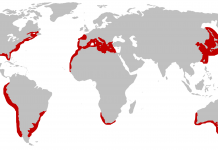Do you have any idea how often do great white sharks eat? The great white shark diet consists of turtles, bony fish, squid, seabirds and even other sharks and rays. The white shark however loves to feed on marine mammals most. Most of these are large and very strong which means each animal brings a lot of calories with it. Thus, when the great white preys on any one of these mammals, it takes in a lot of calories enabling the shark to gorge on them. This is because there is a thick layer of fat under the mammal’s skin in what is known as the blubber.
How often do Great White Sharks Eat?
As compare to proteins, the fat contains twice as much calorie. It means if a great white feeds on a large mammal, it can go for days without eating anything because of high-energy diet. Therefore, a shark measuring about 15 feet can go for about 45 days without eating anything if it devours 66 pounds of fat from a whale (research conducted in 1980s). Generally it is thought the great whites do not gorge on any animal but they rely on feeding rather sensibly.
However, recent advances in the study of white shark’s eating habits have literally upturned this very assumption that a 2,000-pound shark can go about 1.5 months (without eating anything) when it feasts on a 66-pound thick layer of fat from mammals. This latest study was conducted by the researchers from the University of Tasmania. They tracked 12 individuals at Neptune Islands (South Australia). After calculating the metabolic rates of these great whites, they studied the amount of energy burned as well as the amount of food which is essential in keeping it alive.
As maintained by the research team, when a 5,000-pound great white feeds on sixty-six pounds of thick blubber, it can last for about 15 days on this meal. This study suggests that the predator is far more gluttonous because now it appears as if it feasts about four times as much as previously indicated by the biologists.
The amount of energy required by the white sharks is equivalent to eating a seal pup every three days – Jayson Semmens, Senior researcher at the University of Tasmania
Semmens believes that the U.S. researchers in 1980s studied the metabolic rate of only one shark and that too was a lazy one perhaps.
They’re coming up to some pretty high speeds to catch the seals. Their metabolic rate or the engine that runs them is much faster than what we had assumed – Jayson Semmens, Australian ABC News
Optimal Foraging Theory Model - How often do Great White Sharks Eat at One Time?
A model that gives us some idea about how a predatory animal like shark makes up its mind in respect of the high or low-calorie content in its food is the optimal foraging theory. As stated by this model, such animals either seek out for high-energy food or low-energy food in large numbers based on the price that they have to pay in their pursuit. For that reason, it divides them into two strategies: energy maximizers and numbers maximizers.
In their former strategy, the predators stalk the prey which is high in calories but their cost of pursuit is equally high. However, once the shark grabs such kind of prey, it doesn’t really need to go any further in search for another one as a result of high energy that this food brings with it.
In the latter strategy, the predators feed on almost anything which is readily available no matter how much calories it contains. Hence in this case, the energy per meal may be low but one of the gains is that it takes much less effort for the sharks to search for this kind of food i.e. the price for search is low.
Considering this theory, it is evident that white sharks also employ any one of these two strategies for hunting depending on the particular environment. One marine biologist named A. Peter Klimley from the University of California proposes that the great whites are energy maximizers which is why they prefer to eat Cape Fur Seals and other mammals like sea lions (that are rich in fat).
The Klimley’s theory seems to carry a lot of weight because the foraging behavior of these sharks on different islands (like South Africa’s Seal Island, South Australia’s Neptune Islands and Farallon Islands in San Francisco) proves just that. On these islands, the great whites readily prey on high-cal Cape Fur Seals as opposed to low-cal seabirds, which are also available though in much lesser quantity of course.
That being said, it is also observed that white sharks do not just follow this strategy alone because there are many low-cal animals on the menu of great white like sea otters, squid, tuna, penguins and so on. A sixty-pound juvenile seal is rich in fat and therefore makes a high-energy food for the white shark anyway.
To end with, the question about how often do great white sharks eat wholly depends on the kind of diet it feeds on.
How often do Great White Sharks Eat? - Video
Sources:
Martin, R. Aidan and Anne Martin. “Sociable Killers”. Natural History
Foley, James A. “Great White Sharks Eat Four Times as much as Previously Estimated”. Nature World News







